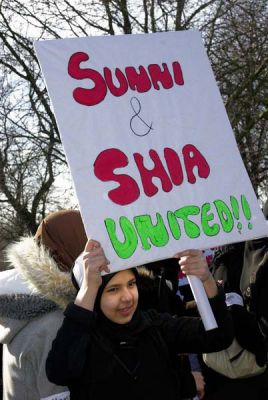 I tried to find a religious news angle for the Super Bowl halftime show so I could discuss how awesome Prince is, but I had to give up.
In completely opposite news, Neil MacFarquhar had a wonderfully intriguing article in the Sunday New York Times on how the Sunni-Shiite split is affecting communities in the United States. I've complained before that we don't read enough about the doctrinal or other differences between the two groups.
I tried to find a religious news angle for the Super Bowl halftime show so I could discuss how awesome Prince is, but I had to give up.
In completely opposite news, Neil MacFarquhar had a wonderfully intriguing article in the Sunday New York Times on how the Sunni-Shiite split is affecting communities in the United States. I've complained before that we don't read enough about the doctrinal or other differences between the two groups.
McFarquhar gives myriad examples of the tension, from vandalism against Shiite mosques in Dearborn to Shiite students being barred from leading prayers at the Sunni-dominated Muslim Student Associations. He puts the problems in context:
Though the war in Iraq is one crucial cause, some students and experts on sectarianism also attribute the fissure to the significant growth in the Muslim American population over the past few decades.
Before, most major cities had only one mosque and everyone was forced to get along. Now, some Muslim communities are so large that the majority Sunnis and minority Shiites maintain their own mosques, schools and social clubs. Many Muslim students first meet someone from the other branch of their faith at college. The Shiites constitute some 15 percent of the world's more than 1.3 billion Muslims, and are believed to be proportionally represented among America's estimated six million Muslims.
Sometimes doctrinal differences are difficult to describe. Or it's easier to show the obvious areas where two groups clash rather than delving into the nitty gritty. One thing I liked about the MacFarquhar article was the way he explained differences over Ashura, the day when Shiites commemorate the seventh-century death of Mohammad's grandson Hussein:
The Shiites and the Sunnis part company over who has the right to rule and interpret scripture. Shiites hold that only descendants of Mohammad can be infallible and hence should rule. Sunnis allow a broader group, as long as there is consensus among religious scholars.
Many Shiites mark Ashura with mourning processions that include self-flagellation or rhythmic chest beating, echoing the suffering of the seventh-century Hussein. As several thousand Shiites marched up Park Avenue in Manhattan on Jan. 28 to mark Ashura, the march's organizers handed out a flier describing his killing as "the first major terrorist act." Sunnis often decry Ashura marches as a barbaric, infidel practice.
MacFarquhar hits from all angles. He shows how the Ashura problem is fought by both sides and the concerns Shiites have that speaking out against the problem will undermine unity among Muslims. Attempts to resolve conflicts have been mixed.
One of the differences that pose problems involve prayer. The University of Michigan at Dearborn's Muslim association wrote rules that have the effect of banning Shiites from leading prayers, he said:
Apart from a greater veneration among Shiites for the Prophet's descendants, there are slight variations in practice. Shiites, for example, pray with their hands at their sides, while Sunnis cross them over their chests.
"Most Sunni Muslims can't pray behind a Shiite because if you are praying differently from the way the leader is, then it doesn't work, it's not valid," said Ramy Shabana, the president of the association on the Dearborn campus.
I had never heard about this difference, or some of the others mentioned in the article. It provides some much needed information that helps shed light on Muslims here in America and abroad.
The only thing that concerned me in the article was that it seemed that all of the antagonism came from Sunnis and that Shiites were always the victims. I'm not aware of what the truth is, and the article did include a few Sunni sources, but it may be cause for concern.
Of course, the Shiite perspective taught me many things, such as that they believe the Council on American Islamic Relations and the Islamic Society of North America are biased toward Sunnis. Both organizations denied the charge.
The article is tightly written and jam-packed with information and perspective. Any reporting that explains the Sunni-Shiite divide is welcome. The interesting twists and illuminating anecdotes make this one all the better.
